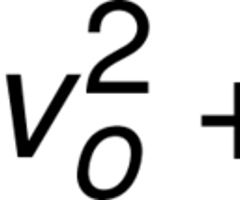Physics Formulas
0.0(0)
Card Sorting
1/102
Study Analytics
Name | Mastery | Learn | Test | Matching | Spaced |
|---|
No study sessions yet.
103 Terms
1
New cards

use this equation to determine the velocity given the displacement or speed and the distance.
2
New cards

use this equation to determine acceleration
3
New cards

use this equation to determine the change in displacement holding the acceleration constant
4
New cards

use this equation to determine the final velocity given initial velocity, time, and holding acceleration constant
5
New cards

use this equation to determine the final velocity given initial velocity, change in displacement, and holding acceleration constant
6
New cards

use this equation to determine the average velocity
7
New cards

use this equation to determine the velocity in a free fall scenario where acceleration due to gravity is equal to 9.8 m/s²
8
New cards

use this equation to determine the centripetal acceleration of an object moving in a circle at a constant speed
9
New cards

use this equation to determine the centripetal force of an object moving in a circle at a constant speed
10
New cards

use this equation to determine the gravitational force btw. two objects
11
New cards

use this equation to determine the the force on an object due to kinetic friction
12
New cards

use this equation to determine the static friction acting between two objects which are stationary due to each other
13
New cards

use this equation to determine the Newton's Second Law.
14
New cards

use this equation to solve for gravitational potential energy in situations relatively close to Earth's surface
15
New cards

use this equation to solve for kinetic energy.
16
New cards

use this equation to determine the torque or moment of force
17
New cards

use this equation to determine work where θ is the angle btw. the force and the displacement vector
18
New cards

use this equation to determine the momentum of an object in motion
19
New cards

use this equation to determine the capacitance of a capacitor
20
New cards

use this equation to determine the potential energy stored in a capacitor
21
New cards

This equation describes the potential energy of a point charge in an electric field due to an electric force times displacement of the charge (arbitrary, similar to gravitational pot energy)
22
New cards

use this equation to determine the attractive or repulsive force two charges exert on one another
23
New cards

use this equation to determine the potential energy due to two point charges
24
New cards

use this equation to determine the magnetic force on a moving charge in an external magnetic field.
25
New cards

use this equation to determine the drop in electric potential across a resistor
26
New cards

use this equation to determine the total electric current passing through a conductor per unit of time
27
New cards

use this equation to determine the magnitude of the magnetic field produced by a circular loop of current-carrying wire at the center of the loop
28
New cards

use this equation to determine the magnitude of the magnetic field produced by a straight current-carrying wire at a chosen point in space.
29
New cards

use this equation to determine the magnetic force on a current-carrying wire in a uniform external magnetic field.
30
New cards

use this equation to determine the magnetic force
31
New cards

use this equation to determine the weight of an object
32
New cards

use this equation to determine Newton's Third Law
33
New cards

use this equation to determine the rate at which energy is transferred from one system to another
34
New cards

use this equation to determine the conservation of mechanical energy when no dissipative forces are present
35
New cards

use this equation to determine the total mechanical energy
36
New cards

the expression of the relationship btw. work and energy theorem
37
New cards

use this equation to determine the change in momentum or Impulse
38
New cards

use this equation for conservation of momentum during elastic and inelastic collision
39
New cards

use this equation for conservation of Kinetic Energy during completely elastic collision
40
New cards

use this equation for conservation of momentum during completely inelastic collision
41
New cards

use this equation to determine the ratio of the force exerted on an object by a simple machine (Fout) to the force actually applied on the simple machine (Fin)
42
New cards

use this equation to determine the efficiency of a machine
43
New cards

use this equation to determine the center of mass
x \= the x-axis at that point
44
New cards

use this equation to convert btw Celsius and Kelvin
45
New cards

use this equation to determine the change in lenght of an object subjected to a change in temperature
L \= original lenght
α \= constant that characterizes how the lenght change as temperature change
α \= constant that characterizes how the lenght change as temperature change
46
New cards

use this equation to determine the change in volume of a fluid or object subjected to a change in temperature
β \= 3α
47
New cards

use this equation to determine the change in total internal energy of a system undergoing a thermodynamic process
48
New cards

use this equation to determine the heat gain or lost by a substance subjected to a change in temperature
c \= specific heat
49
New cards

use this equation to determine the heat gain or lost by a substance subjected to a change in phase
50
New cards

use this equation to determine the work done on or by a system that undergoes a change in volume at constant pressure
51
New cards

use this equation to determine the change in entropy of a system at a given temperature
52
New cards

use this equation to determine the electric field produced by a source charge at a chosen point in space
K \= electrostatic constant \= 8.98 × 10⁹ Nm²/C²
53
New cards

use this equation to calculate the electric potential energy btw two charges separated in space
54
New cards

use this equation to determine the electric potential due to a known source charge at a chosen point in space
55
New cards

use this equation to determine the electric potential at a point in space due to an electric dipole
56
New cards

use this equation to determine the electric field due to an electric dipole along the perpendicular bisector of the dipole
57
New cards

use this equation to determine the net torque experience by an electric dipole about the center of the dipole axis due to an external electric field
58
New cards

use this equation to determine the force experience by a charge in an electric field
59
New cards

use this equation to determine the magnetic field produced by a straight current-carrying wire at a chosen point
i \= current in wire
µ₀ \= permeability of free space \= 1.26 ×10⁻⁷ Tm / A
µ₀ \= permeability of free space \= 1.26 ×10⁻⁷ Tm / A
60
New cards

use this equation to determine the magnetic field produced by a circular loop of current-carrying wire at the center of the loop
i \= current in wire
µ₀ \= permeability of free space \= 1.26 ×10⁻⁷ Tm / A
µ₀ \= permeability of free space \= 1.26 ×10⁻⁷ Tm / A
61
New cards

use this equation to determine the magnetic force on a moving charge in an external magnetic field
θ \= smallest angle btw qv and B
62
New cards

use this equation to determine the magnetic force on current-carrying wire in a uniform external magnetic field
L \= length of wire
63
New cards

use this equation to determine the total electric current passing through a conductor per unit of time
64
New cards

use this equation to determine the resistance of a given resistor
p (resistivity) \= number that characterizes the intrinsic resistance to current flow of a material
65
New cards

use this equation to determine the resultant resistance of multiple resistors in series
66
New cards

use this equation to determine the power dissipated by a given resistor
67
New cards

use this equation to determine the resultant resistance of multiple resistors in parallel
68
New cards

use this equation to determine the capacitance of a parallel plate capacitor
ε₀ (permittivity of free space) \= 8.85 × 10⁻¹² F/m
69
New cards

use this equation to determine the increase in capacitance due to a dielectric material
C' \= new capacitance
K (dielectric constant) \= measure the insulating capability of a dielectric material.
K (dielectric constant) \= measure the insulating capability of a dielectric material.
70
New cards

use this equation to determine the electric field at a point in space btw the plates of a parallel plate capacitor
71
New cards

use this equation to determine the resultant capacitance of multiple capacitors in series
72
New cards

use this equation to determine the resultant capacitance of multiple capacitors in parallel
73
New cards

use this equation to determine the total voltage drop across multiple resistors and multiple capacitors in parallel
74
New cards

use this equation to determine the total voltage drop across multiple resistors and multiple capacitors in series
75
New cards

use this equation to estimate the current in an AC system
76
New cards

use this equation to estimate the average magnitude of alternating current over one period
77
New cards

use this equation to estimate the average magnitude of AC voltage over one period
78
New cards

use this equation to determine the actual voltage supplied by a cell to a circuit
79
New cards

use this equation to determine the restoring force for a spring
Hooke's Law
80
New cards

use this equation to determine the angular frequency for a spring
k - spring constant
81
New cards

use this equation to determine the angular frequency for a pendulum
82
New cards

use this equation to determine the potential energy of a spring
83
New cards

use this equation to determine the restoring force for a pendulum
84
New cards

use this equation to determine the sound level
I₀ - is a reference intensity set a the threshold of hearing: 1 x 10⁻¹² W/m²
85
New cards

use this equation to determine the speed of a wave
86
New cards

use this equation to determine the change in intensity of a sound
87
New cards

use this equation to determine the beats that its created when two sounds waves have nearly equal frequencies in the audible range.
88
New cards

use this equation to determine the perceived frequency of a sound and its actual frequency when the source of a sound and the sound's detector are moving relative to each other.
89
New cards

use this equation to determine the wavelength, and the length of a closed pipe ( n \= odd integer)
90
New cards

use this equation to determine the wavelength of a standing wave of a strings, and the length of an open pipe ( n \= positive non-zero integer)
91
New cards

use this equation to determine the average rate per unit area at which energy is transferred across a perpendicular surface by the wave
92
New cards

use this equation to determine the ratio of mass to volume
93
New cards

use this equation to determine the ratio of normal force per unit area - pressure
1.013 × 10⁵ Pa \= 1atm \= 760 torr \= 760 mmHg
94
New cards

use this equation to determine the Pascal's Principle
95
New cards

use this equation to determine the total pressure that is exerted on an object that is submerge in a fluid - Absolute Pressure
96
New cards

use this equation to determine the difference btw the absolute pressure inside a container and the atmospheric pressure outside the container - Gauge Pressure
97
New cards

use this equation to determine the buoyant force
98
New cards

use this equation to determine the critical velocity of a fluid at which turbulence can arise
NR \= Reynolds number
η \= viscosity of the fluid
η \= viscosity of the fluid
99
New cards

use this equation to measure the linear displacement of a fluid particle in a given amount of time - Continuity Equation
100
New cards

use this equation to determine the relationship btw absolute pressure, dynamic pressure, and gauge pressure of a fluid - Bernoulli's Equation